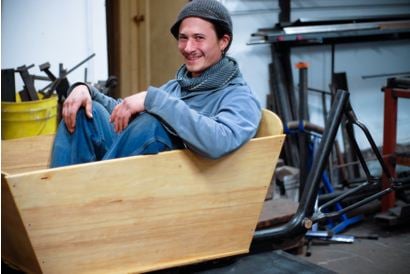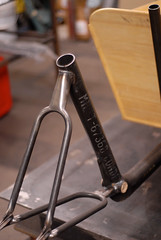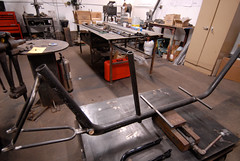
(Photo © J. Maus)
Since I first announced that a Portland-made bakfiets (Dutch for “box bike”) was in the works last May, the two men behind the project — 26 year-old Jamie Nichols and 38 year-old Phillip Ross — have made considerable progress.
The two partners will call their venture Metrofiets and they plan to soon offer a Portland-built, bakfiets-type cargo bike based on the proven design that has been in use in similar forms for nearly a century in Europe.
A few days ago I paid a visit to the shop in Northeast Portland where metal fabricator Jamie Nichols gave me an update and a sneak peek at the bike.
So far, Nichols and Ross have completed the design and fabrication of the main frame portion of the bike as well as the cargo box, which is also being built locally. At first glance, the Metrofiets looks like a carbon copy of the bakfiets design made popular by Dutch builder Maarten van Andel — and that’s no accident.
Nichols and Ross studied the existing bakfiets design extensively and used it as a jumping-off point for their creation.
“They’ve been doing this basic design for 100 years, so it’s pretty well figured out already,” says Nichols, “so we’ve taken that and added a bit of flair.”
Part of that flair, evident in the wishbone seat-stays, is inspired by Nichols’ love of vintage American bicycles like the Monark Silver King that were popular in cities like Chicago in the 1930s and ’40s.
According to Ross and Nichols, the other differences between their Metrofiets and the traditional bakfiets are that their bike will have a larger front wheel (24-inch instead of 20-inch) and a higher headset, which they say will “change the geometry so that it tracks differently.” Nichols also says the larger front wheel will help prevent speed-wobbles and will make the bike easier to control. Another difference is that the Metrofiets is made from 4130 chromoly, while the traditional bakfiets is made from a heavier grade of steel.
Ross, who works on the business end of the company, says they will also offer many customization options. “We’ll have a basic version available,” he says, “but we will also be able to tailor the size to the needs of any individual.” According to Ross, customers will be able to choose dropout types, component mix, and even frame angles depending on the kind of ride characteristics they prefer.
Both Ross and Nichols, who met 12 years ago in a Portland coffee house and have been friends ever since, say they want to keep their venture “hyper-local” and sustainable. They’re working with local craftsmen to build the cargo box (the current one was made out of a single piece of plywood and future models might be constructed from a ballistic nylon material instead of wood), and a local mobile bike mechanic will do all their builds and maintenance.
Current plans are to build two units a month for the first full year of production. Both Ross and Nichols shied away from a specific ETA for the bikes and they aren’t currently taking orders, but a final production model will almost certainly be ready to go by this September, when Nichols plans to ride a Metrofiets in Cycle Oregon.
View a few more photos of my visit to the Metrofiets shop in the photo gallery.









Thanks for reading.
BikePortland has served this community with independent community journalism since 2005. We rely on subscriptions from readers like you to survive. Your financial support is vital in keeping this valuable resource alive and well.
Please subscribe today to strengthen and expand our work.
4130 is steel…
That\’s essentially what he said Scott. Chromoly is steel.
\”4130 is steel…\”
Thanks Scott. I edited that sentence a bit to make my point more clearly.
I\’ll preface my comments by noting my biases: My firm WorkCycles sells the Bakfiets.nl Cargobike. I have contributed to its development and its designer, Maarten van Andel is a friend as well.
I\’m all for local production when it truly delivers environmental and social benefits, and of course I want to see bicycles replacing automobiles as quickly as possible. However, this particular story doesn\’t resonate well with me.
Long John format transport bikes with a carrier held low behind the front wheel do indeed date back to at least the 1930\’s. They have been built, always for cargo (not child) transport, in at least Denmark, Sweden, the Netherlands and England.
However the design of Maarten van Andel\’s Bakfiets.nl Cargobike for family transport is very unique, dates from 2001 and certainly not in the public domain yet.
Claiming that this bike is nothing more than one of many generic versions of an old \”proven design\” is deliberately misleading. It also ignores the numerous model protections, patents and copyrights that protect van Andel\’s design.
Metrofiets has carbon-copied van Andel\’s bent, single-tube frame with the continuous reinforcement rib underneath and bottom-bracket shell mitered halfway into the main tube. Further their box appears to be utterly identical right down to the curvature of the back and little triangular steps on the side.
It is not only extraordinarily unoriginal of Nichols and Ross, but their denial of van Andel\’s intellectual property suggests dishonesty too. At the risk of taking my criticism too far I\’ll add that Ross has contacted me on numerous occasions to collect design information without disclosing his identity, plans or intentions.
Working toward one\’s own chosen ideals simply doesn\’t entitle violating the rights and ideals of others. That\’s what these guys are doing.
Met vriendelijke groeten,
Henry
Dear Henry,
My English is not as good as yours but i can be very short about this. Your Workcycles cargobike is almost an idential copy of the Bakfiets.nl so who are you to talk about copying and intellectual property etc? The differences between Metrofiets and Bakfiets.nl are plenty, much more so than with your bike…
I have no idea what any of that means (not even counting the part in Dutch,) but it sounds like somebody just got called out.
Oh!
Um, I\’m not sure either, but I think Henry is accusing our local boys of copyright and patent infringement. Is a cease-and-desist letter soon to arrive in their mailbox? Or does van Andel hold any such rights in the US? Is it even possible to patent such a design?
Maybe I\’ll take up the practice of bike IP law. We certainly have enough creative local builders. And I bet lots of these guys haven\’t considered the need to legally protect their novel frame designs…
Henry,
When I asked Phillip about this (after reading your comment on my Flickr photo) he assured me that he searched all U.S. and foreign patent libraries for any mention of the bakfiets design… and he found none.
..I\’ll let Phillip respond himself if he\’d like…
\”Ross has contacted me on numerous occasions to collect design information without disclosing his identity, plans or intentions.\”
uncool.
Hey all,
If there are indeed there are valid US patents in existence then of course we honer it/them and build a different kind of cargo bike. However, to date, I have not found such a patent nor have I been informed by folks who would be in the know if they do or do not exist.
Henry, if you have it or know of it please, email it to me.
That was the first thing I wondered — how can you just flat out copy such a unique machine while still respecting both the letter and the spirit of copyright protection? I thought that the builders must have figured that out, but I am very concerned about Henry\’s response.
I guess they should be going after the Center for Appropriate Transport down in Eugene who has been building these since 1986.
Why send money abroad. Buy Local!!
http://www.catoregon.org/hpm/longhaul4kids.htm
I don\’t know about any of the intellectual property stuff but as I understand it you can only see a Bakfiets.nl Cargobike in like three shops in all of North America. These guys are starting on a project that this country needs, US built family bikes. If there prices are close I would probably choose a local producer regardless of the intellectual issues. I would also hope that as they produce more and get some ideas from custom orders a more individual style will emerge.
More Family bikes!!! HOORAY
Copyright applies to written and performance work. Patents apply to manufacturable designs.
A *novel* bicycle design could be patented, but no part of it could be subject to copyright infringement.
As for patentable aspects, there is a lot of possibility (things like the aforementioned reinforcing rib, bottom bracket miter, and box running board qualify), but that 1) doesn\’t mean they are patented and 2) doesn\’t mean the patents could not be easily designed around.
All in all, intellectual property is incredibly specific and arcane. Trying to discuss and debate it in blog comments is fool-hardy.
Though I should have added I respect Henry\’s desire to state his peace in the matter.
This is just part of Jamie\’s collection. You should see his other masterpieces.
#11 Spencer,
The van Andel version is far better designed and more finished than the rough version that the Center for Appropriate Transport in Eugene makes. I talked with CAT folks at the Oregon Bike Builders show a few months ago and the CAT guy admitted that they had only made 3 of the kid carrying versions of their long hauler and they were showing the 3rd one at the show. He gave me a very hard time for buying the dutch bike, but I told him that the dutch version was better for these reasons:
1. fully enclosed chain (no grease on the pants)
2. very low step over height to mount the bike (the CAT version is like a standard road or mountain bike so a woman can\’t wear a skirt riding)
3. a very well designed rain cover (CAT doesn\’t offer)
4. availiblity- There is a market (proven by Clever Cycles) yet they have not started producing more bikes to meet the demand.
His only response was that the \”top tube\” provides an excellent place to hang a u-lock from\”. Too bad he didn\’t realize that you don\’t even need a u-lock with the bakfiets because ithat is semi-built into the bike.
The only thing that I see as a possible advantage to the CAT bike is the ability to have more gears and disc brakes, but I have not had too much of a problem with 8 speeds and drum/roller brakes. Disc brakes might be a problem with such a heavy bike (locking up the wheels on wet pavement?).
My wife and I had long conversations about which one to buy and seriously considered buying from CAT but since they don\’t seem to respond to inquiries and their bike doesn\’t seem as user friendly for everyday family transport we bought dutch last June and have really enjoyed it.
The nice folks at Clever Cycles are really doing a good job promoting and supporting this kind of product.
Just my 2 cents.
im totally stoked on everything about this except for two things:
1. the 24\” front wheel. as someone who rides a long john style cargo bike for half the week, for work and play, carrying serious loads, the 20\” front wheel is one of the best things about this design – it means as low a center of gravity for the cargo bed as possible, with a minimum of long tubes – and it means the strongest possible front wheel – a big issue with front wheels on cargo bikes of this style is side loads on the front wheels while turning. theres a reason theyve always been 20\” wheels, and its not just tradition. while i would be stoked to find a reliable source for a locally made long john style cargo bike, and would likely even consider getting one if possible, a front wheel bigger than 20\” nixes the deal for me – but again, im thinking in terms of cargo (like 200-400 lbs of cargo) rather than groceries or children.
2. the \”copyright\” \”issues\” – while i wont take up a position on either metrofiets or workcycles side of this argument – it does look like a lot of the bike metrofiets is building is straight-up copied from the bakfiets.nl design, which, while derived from traditional long john style cargo bike design, was a definite depature from that design as well, and frankly, thats a bit different than the copying CAT did from the traditional danish/dutch/english designs. (though hey, i will say the cat kid box design is nicked from *somewhere* familiar… 🙂 ) but i often have a tenuous relationship with the concepts of intellectual property, so ill say that my biggest issue in this department is the accusation of disingenous queries – that, if indeed the cause, is not cool, and bothers me more than the actual design copying.
and for what its worth, child seats for the traditional long john style bikes (that hooked into their tubular cargo beds) were available for some time – so child-carrying was an option as well, though not a primary purpose.
oh, and that being said, if they start work on a possible production cargo trike, a la dutch and danish examples from as far back as the 1890s, with a cargo bed as big as that of small pickup, color me VERY interested. the us could use a serious cargo trike (ie beyond the capabilities of a christiana or worksman)
funny – I just wrote a review of the Bakfiets today:
http://bike2work2live2bike.blogspot.com/2008/02/is-that-wheelbarrow.html
as exiting as it may sound to have something so cool and functional built here locally, I have a hard time imagining that someone can produce as complete a package as the Dutch have with their Bakfiets cargobike. At least in just a year of production. It was a hard decision for my wife and I to buy a bike that had to be transported thousands of miles to get into our hands – but the goal of being car-free trumped that concern. Now that we have it, we couldn\’t be more pleased with the product. The Bakfiets has very obviously had Many Many years of design iterations, and every detail is well thought out and well executed. I took a good hard look at a CAT cargobike parked in front of People\’s Coop last year and I was shocked with how poorly it compared, feature for feature, with the Bakfiets. It costs and weighs about the same, so the only upsides are what? That it\’s more customizable and produced in Oregon? (Frankly I was surprised that the Bakfiets could compete with a local product since it had to be shipped so far.) For something I spend so much time riding, I\’d be hesitant to settle for an inferior product just because it\’s local. Inferior = my opinion; I\’m sure there would be plenty of folks who disagree with that statement. Jamie and Phillip have their work cut out for them. The bar has been set high by Bakfiets.
I must admit though – I love those wishbone seat-stays. Very nice touch!
in defense of the cat long haul, and as a cat long haul owner myself, i think that the long haul and the bakfiets.nl bike are designed for different purposes – very similar different purposes, but…
the long haul is closer to being a pure cargo bike – that is the history of that particular design (which jan tweaked only slightly from its danish/dutch/english ancestors). the bakfiets.nl design, to me, seems to have a more family-oriented design, more built around hauling groceries, children etc. the box, to me, is a limiting factor in load-carrying capability – thats the same issue i have with the optional lockable box on the cat long haul. for large or odd size cargo, a plain platform is better, hands-down, and this is the strength of the long haul and its precursors.
i have my quibbles with the long haul, but its not an inferior product – just designed for a slightly different purpose. for what i use my long haul for, i would not choose a bakfiets.nl bike – not unless it had a platform instead of the box, and had disc brakes and more gears – but thats me.
\”If there are indeed there are valid US patents in existence then of course we honer it/them and build a different kind of cargo bike. However, to date, I have not found such a patent nor have I been informed by folks who would be in the know if they do or do not exist.\”
So, are you saying you would not feel obligated to honor a Dutch patent? You might want to contact an IP lawyer, and you might want to do it quickly.
even if there is a dutch patent, wouldnt all the ip hoo-ha in the world be a moot point until it hits production with a patent-infringing design? i mean, arent they still in the prototyping stage? of course, theres probably some \”with-intent-to-produce\” mumbo-jumbo out there in ip law land…
really, theres a limited number of basic designs possible within the constraints of this particular cargo bike design. the only basic difference between the bakfiets.nl frame (exclusive of differences in the cargo box/platform) and that of the traditional long john, from what ive seen, is the absence of a top tube. theres some other little tweaks going on there, but thats the only major one from where i sit – most all the other differences are nitpicking, in my book. but hey, im not an ip lawyer – im just a guy who rides bikes, and realizes that virtually every bike on the road is a design ripoff of something else.
While I have for a while been calling for more American made cargo\’s to be made available, instead of supporting and importing over priced, lower quality European tanks, I must say:
This is a self proclaimed copy, with design changes that, as pointed out by Joel (who very much knows what he is talking about on this and many other matters) are less than effective to the overall performance of this style of bike.
And I strongly agree with Joel that the smaller, stronger front wheel is, and has been used, for very good reason, and should continue to be the standard.
And then to justify it by stating that it is OK, simply because there is no American patent on it?
I mean, they are in Europe. Who is to know? Well, it appears everyone, if not now, then soon enough. Maybe there are no lawyer\’s in Europe?
It sounds more reasonable to put more work into it, take the time, and come up with your own functional, and possibly better version?
One that you can call your own. And actually feel proud to put your name on, and offer to people in your own home town.
What is the word I am looking for?
Plagiarism?
Yeah I think that is the one.
Though the admission of doing so means it does not exactly fit the definition of the word, a rose of the same color might smell as \”sour\”?
I am sure with a little more work, you could come up with some fine, Portland \”designed\” cargo\’s, as well as Portland made.
I am sure with a little more work, you could come up with some fine, Portland \”designed\” cargo\’s, as well as Portland made.
I think Dabby\’s thought is the perfect, most succinct response possible to this post.
While Metrofiets may have indeed done their best version of a patent search on the bakfiets, they are borrowing from a now iconic design – a design that another designer worked diligently to perfect. That this designer happens to live in Holland is immaterial.
US patent or not, they are employing the tactics of companies like Pottery Barn who \”borrow\” ideas from other designers, tweak them just a bit, then sell under their own banner for profit.
Legalities aside, the nature of this feels really wrong, no matter the spirit or intention behind it.
I think the reason no one has found a patent for this design is that it is unpatentable. Specifically, my lay understanding of patent law is that a design has to be sufficiently innovative to be deemed \”non-obvious,\” or a similar adjective. A bike with a big square bucket would probably fail this test, as I understand its application. That\’s not a judgment of the design, just a (barely) educated opinion on patentability.
An example of a patentable bike-related invention would be a deraileur, which is useful and not obvious.
Is it immoral to copy this design?
Is it immoral for any bike builder to fuse two triangles of metal together, put in a fork, two wheels, and handlebars? Somebody invented that design.
Imagine how much bikes would cost if one person could patent the design. That company would be called Microsoft, and…
I\’m pleasantly surprised to not have been flamed out of Cascadia yet. Thank you Portland. I essentially agree with the spirit of many of the comments above.
If Metrofiets were busy building a unique bicycle, and preferably doing so without underhanded tactics I would support their project wholeheartedly.
However this is not the case. They\’re not just building another bicycle of a basic archetype, they are building a knock-off that mimics another\’s original work from its broad appearance and unique construction to many tiny details… and that they attempt to justify this with various vague excuses ranging from local production to disclaiming IP rights. Legally defensible or not, that\’s not cool.
There\’s some confusion about the intellectual property laws involved so here\’s some added info:
I\’m also no IP expert and I do not know (nor would it be appropriate to share here) precisely what protections van Andel holds on the Bakfiets Cargobike and its various special components. Its worth noting, though, that the Cargobike has already been successfully defended against Chinese made knock-offs less identical than the Metrobike prototype.
I do, however, develop products and have a basic understanding of the protection possibilities. Its not as simple as a.O states: There are utility patents that cover the function of processes and mechanisms, design patents that cover ornamental or non-essential designs, and copyrights can indeed be used to protect original work beyond literature, art and so forth. How these can be constructed, combined and defended in various regions is very complicated business.
-Henry
Golly, lawyers aside, I can\’t help but imagine that this situation is sort of like when the \”safety bicycle,\” for instance, was first released. Probably there was one firm that developed it, and had a corner on the market for a little while. But, pretty soon, they were being made by all kinds of firms, all over the world. Why? Because the design just made sense. And a few tweaks to the geometry here, and the materials there, and pretty soon you\’ve got the modern bicycle.
Sam with the bakfiets. There is absolutely no logical reason why this type of machine should only be manufactured by one firm, halfway around the world. If it\’s a viable idea, it should be produced widely, with many variations. The fact that our local firm is using a different grade of steel, a different-size front wheel and different geometry for the seat stay indicates that this already is not a true copy, but rather a variation on the design.
So, Metrofiets, go forth, be fruitful and multiply lots of locally-made bike-trucks. The citizenry needs them, and if the market supports it, competition will flourish.
Well to jump into the fire on this…I love my bakfiets.
I just hate to see the 2nd rate copies now on the street in Amsterdam. So having said that … there is room for design evolution that the Portland designers could make…perhaps buy the beer and brats at the Amnesia pub for a brainstorming session among local bakfiets users…so that we avoid only lawyers making a profit off of this issue. I would hope that the market deepens (vs. flattens out) so that all may make a living off of this type of bike while the design improves/ localizes.
In Amsterdam there is a wide variety of box materials and shapes in use. Perhaps this is one area to start on.
My wooden box here in Portland tends to mold over in the winter on the edges…when I store it outside or in garages with dirt floors.
And to Metrofiets…avoid the short box…the long box is the way to go …and simplify the design.
Perhaps just make a flat bed?
Garlynn,
I would agree wholeheartedly if your statements were true but they\’re not and they miss the spirit of my argument.
This is not a question of \”this type of machine\”, as it is universally recognized that cargo-carrying bicycles of this basic format date back many decades. CAT\’s Long Haul, for example, is a modern update of one of these classic designs and its made in Oregon. I admire CAT\’s activities.
The Metrofiets, however, is an extremely literal copy of a unique design by another individual, not a variation on a generic archetype. Changing a grade of steel or the size of a wheel do not negate this.
As another commented above Metrofiets need to develop their own unique bicycle and to do so with integrity. Then Portland will have a valuable product to be proud of, as Amsterdam does now.
-Henry
Or use a historical \’cross\’ step thru frame style to avoid the bakfiets step thru frame style.
I hate all of this intelectual property crap. I am planning on building an extremely unique bike that will require multiple patentable innovations. I will indeed patent them, BUT I will license the patents for free to anyone who will also let people use their patents for free. Those who won\’t release their patents won\’t get to use my innovations. Intelectual property is an old fashioned concept from monopolists of the past, and it needs to die.
\”The Metrofiets, however, is an extremely literal copy of a unique design by another individual, not a variation on a generic archetype. Changing a grade of steel or the size of a wheel do not negate this.\”
ok, ill bite. *what* exactly, outside of the specific construction of the cargo bed, is unique about the bakfiets? i havent lined one up next to my long haul and reviewed differences, point by point, so id really like to know. as i mentioned earlier, the only significant difference i see at cursory glance, is the lack of a \”top tube\” in the cockpit area. beyond that, the van andel bakfiets, to me, in terms of its basic frame structure, is a simple variation of a generic archetype itself.
im not saying it should be outright copied because of this, im just really wondering what it is that makes the frame, specifically, so unique as compared to the long haul, or traditional long john style cargo bike frame – cause im just not seeing that much difference when i look at it.
Oh brother- just go out and build your freakin\’ bikes!
racer x, that is one excellent idea you have going there with the \”Portlander Bakfietsen Familie\” beer and brats brainstormfest at Amnesia (or other). the demand is here, the question is out, and Portland has specific cargo needs that local shops could fill and then some. maybe ask some of the local siblingren from NAHBS fame to put in their 2 on the matter, and the result would be something that would put IP and other bandied-about two-letter acronyms to rest for good and sure. at the very least, what a fun gathering that would be! i have but a small trailer, but perhaps there is room for the odd wallflower?
Has anyone from the local company called up the Bakfiets company and said \”Hey, is this an infringement of any of your patents or copyrights??? DO you mind if we cop your design?….Do you think we are weasels?\”
I bet they have telephones in Sweden, or Denmark, or wherever, AND, I bet they can find a kid somewhere who actually speaks English, to translate.
Or, we could all just keep guessing.
a.O. — I\’m sure you know what you\’re talking about wrt intellectual property rights. I do know that some \”designs\” (e.g., typefaces), while not patentable, are protected under trademark or copyright laws, in that very derivative designs can be mistaken for the original by the marketplace. Would that be relevant here? Like how Microsoft finally had to settle with Apple for ripping off OS interface elements?
Joel,
With all due respect this is not the forum for the detailed technical discussion that would ensure if I tried to answer your question above. I noted some of the key similarities between Metrofiets and Bakfiets in my first comment #4.
There is always a subjective element in the concept of imitation but given the many ways to design and construct a bicycle of any given format one can state with reasonable certainty that van Andel went to extraordinary lengths to create a bicycle unique from its predecessors, while Ross and Nichols have made little to do so. Instead they justify their plagiarism (yes, a good word!) by denying the originality of the bike they\’ve faithfully copied.
It was this dishonest approach that motivated me to write my first comment.
-Henry
Henry,
Yeah you are getting flammed. It\’s OK, it just shows everone\’s love.
If we extrapolated your logic, the automobile would have never extended beyond the Model T. Instead, competitors came out with similar designs. Some were better, some were worse. The market shifted to the better, and then everyone incorporated the better inovations.
Same thing with cargo bikes. They have been around forever. Bakfeit, just happens to be at the forefront of integrating the best concepts of design into one product and are currently setting the standard. Because of this they have better market presense, high quality and are the standard that everyon compares against.
Accordingly, as the market grows there will be a greater number of companies, new technologies and new materials and the afore mentioned standard will shift. That is the beuty of the open market.
With respect,
Spencer
If anyone knows of someone who has a used one of these bikes, and wants to sell, email me at donovan at gmail dot com. I would love to buy a new one, but they are out of my price range.
There is a simple answer to this issue- let metrofeldts produce the bike, and bakefeldt can sue them… And a patent court can decide.
Personaly I think that a bike is a bike, and beyond a major engineering innovation, a patent might be hard to hold… perhaps a trademark, but I would think the larger front wheel would change the look enough to make that moot.
Secondly, there is another aspect to this- I think the OP is pissing in his own cornflakes. The more cargo bikes there are out there being used, the more people will see them and think \”that could be me\” and start looking at bikes, then bakefeldt could compete on design, construction, finish. All the eurobikes I have seen have a level of finish that is hard to beat. Instead the OP would rather be the only seller of the design, and own a smaller market.
This is not the forum to debate patents- there is a forum and it is called court.
This discussion here is should not be so much about patent law, as about respect for another\’s many years of hard work.
Which is a moral issue.
I am responding to above comments that this is not the place for such discussion.
The patent side of it is the legal issue, which would not be solved for many years. I have read that the actual patent process (applying for) at this time is expected to be 7 years, and the legal battle to protect a patent is at least half that, as our family business is right now dealing with.
While the moral battle can very well be quickly fought in a public forum.
We have all learned that as a group, our growing number of cycling voices can sway public opinion, if not even just in small ways.
I still say that the more cargo bikes there are out there, the more interest there will be in them and the more will be sold, and that all the manufacturers will benefit in the long run. I would never have considered such a thing until I saw one in person, so the more there are out there the better. In the long run Bakfeldt could be create a win win situation out of this.
It sounds to me as if the local boys have come up with a new take on an old idea, and they should be allowed to compete in the open marketplace on the basis of their product, not on the accusations of someone who has an admitted bias.
There is nothing wrong with improving on an existing design, taking the improvements of the past and adding your own, unless such incorperations are ilegal under aplicable (ie patent) law. I am not one to know the nuances of patent law, and barring a legal finding to the contrary, see nothing wrong with the design mentioned.
I consider myself a moral nd ethical person, and would have no issue with purchasing the bike in question- so clearly this is a place where reasonable, moral and ethical people can disagree, which is why we have courts in which these arguments can be made. I will withold judgement against the local builders until such time as they are found guilty of patent/trademrk infringment, because I believe that unless they can be found guilty, they are innocent of ilegal acts.
I am not as morally correct as I would like to be, by the way.
I mean, who really is?
I was mainly pointing out that the court of public opinion tends to be more moral than practical, quicker to act, and certainly does not wait to learn all the facts to reserve judgment.
That is why, in my opinion, an early article about a product such as this, seeming to be based much too closely on another, is generating more negative opinions than positive.
Yet I will still not sit around and wait for the overtly long patent law and appeals process, to tell me what I should think.
I think Henry may have gotten more heat if the last half of the name had been in English and the there was something distinguishing about the box. I want to see Portland made cargo bikes all over the city. But my gut reaction was a little bit of discomfort that the name Metrofiet and the box are so close to Bakfiet.
I believe my discomfort is unfounded, that 18 custom bike makers in Oregon, some with 2+ year waiting lists, aren’t encroaching on each other’s market and have enough uniqueness in their offerings to avoid infringement and that, all said, Metrofiet is also ok. If there are issues, they should be able to be worked out before it goes to market. When I am ready for a cargo bike, I’ll want to buy local and hope to see many original designs from this company. Perhaps an interchangeable box with a flatbed conversion, watertight ‘picnic’ box, shopping cart with ambulance gurney wheel extenders… ok… enough.
henry –
\”With all due respect this is not the forum for the detailed technical discussion that would ensure if I tried to answer your question above.\”
and why not? what is the forum? obviously, something needs to be said to clarify exactly where the line is drawn as far as concerns whether or not a similar style of cargo bike is an ip infringement… stating that there are unique developments in the van andel design, but then being unwilling to state what they are in the same forum doesnt do it for me.
you stated earlier that there are patents out there regarding this frame design – metrofiets states theyve looked for them in the us patent system with no luck. perhaps now would be the time to lay them out, and nip this whole thing in the bud?
joeb –
ive said it already – \”bakfiets\” is a dutch generic, applying to ANY cargo-hauling bike. that van andel chose it as the name for his non-generic design was, well, inviting trouble in that department. complaining about the name is like being bummed about someone elses bike being called \”city bike\” when yours is called \”cargo bike\”. its probably defensible under ip law, im sure, but its damn silly, even if it is.
I love what the \”bakfiets\” represent. I hate the smug they create in slick overpriced bike boutiques.
Henry,
Just imagine how Tom Ritchey felt the first time he saw a Specialized Stumpjumper.
How many beach cruisers look just like Schwinn\’s \”patented\” cantilever frame?
How many American , British, and Italian designs have been \’ripped off\” by China, Taiwan, and Japan? They don\’t even wait until copyrights and patents run out. If the Bakfiet design is so old, maybe the design is public domain anyways.
There are only so many ways to do a monotube frame, a reinforcing rib, and a wishbone rear end. These are utility bikes, so the flourishes of fancy lugwork and unique tube junctures would just drive the price through the roof and be unnecessary. I like the idea of an American made utility bike, hell I like the idea of ANY American made bike, I don\’t know how you can poo-poo that.
4130 is a Chromuim Molybdenum alloyed steel. It is a far cry from the 1020 carbon steel that most mass-produced bikes are made of. I may be alone on this but I always refer to it as Chromoly
because I don\’t think the word steel does it justice, steel is what Huffy\’s are made of. Same with Reynolds, Columbus, Deaedacchi(sp), etc.
I have doubts about a 20\” wheel being weaker than a 24\” wheel, if both are using the same technology. Most freeride and downhill bike are 26\” and some are 24\” and the wheels hold up to abuse that a Bakfiet will never experience. As far as center of gravity goes that is determined by the height of the backbone and not the wheel size. A larger wheel is going to have less bump-steer. A motorcycle steering damper/dampener would be a nice touch, most are adjustable.
skidmark – shorter spokes (number of spokes being equal) = stronger wheel under wind-up and side loads. cargo bike wheels experience an *entirely* different set of loads than freeride/downhill wheels. on a long john type design, torque on the rear wheel pulls spokes out of hub flanges and rims, not to mention tearing tire sidewalls apart. front wheels get crazy side loads from turning with heavy loads. both wheels can have issues with the weight of the load literally splaying the rim down its center. the rim i just took off my rear wheel was splitting in half down its center and cracking along the space between the spoke holes and brake surface. i put that same wheel completely out of true and round carrying a 400lb load of firewood rounds a while back – in 15 short portland blocks – simply from the forces exerted in riding that distance. cargo bike wheels need to hold up to abuse that freeride and downhill bike wheels will never experience. each has something to gain from the experience of the other, mostly in the form of all-around stronger parts, but the stresses are most assuredly different, though equally damaging.
my center-of-gravity comment was more a comment on the fact that a large front wheel required a *longer* boom tube (suporting the cargo bed/box) to achieve the same center of gravity, and a longer boom tube is either heavier or weaker than it needs to be with a 20\” wheel. i am completely convinced that for cargo bikes of the cycletruck/filibus/long john vernacular, a 20\” wheel is absolutely the way to go. theres a reason its been the historical wheel size of choice for these bikes.